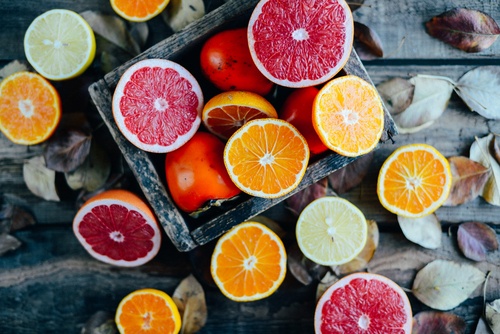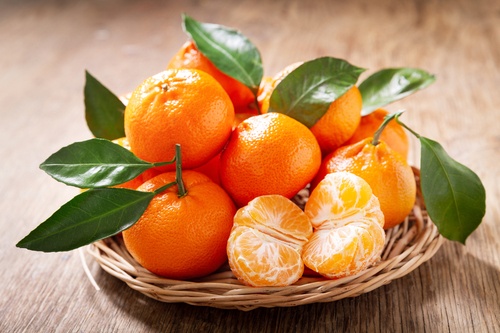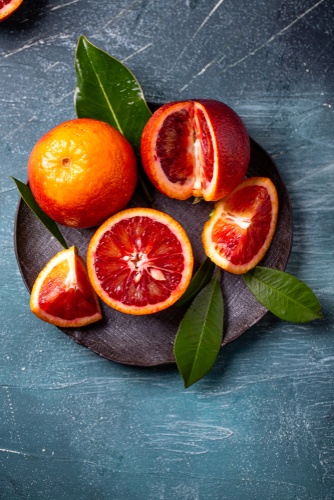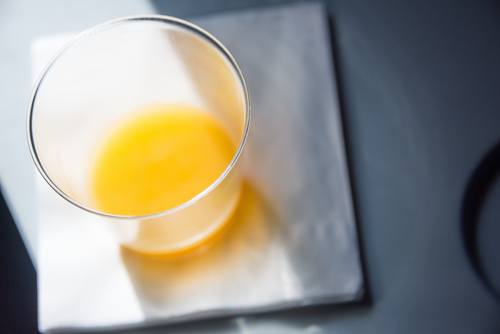My mom has always been the best person to take care of me when I’m sick. She would always give me chicken soup with an orange on the side. Seemed an odd pairing, but Mom always told me it was important to get plenty of rest and Vitamin C when you’re sick, and she knew I loved oranges.
What is Vitamin C and Why Do We Need It?
Oranges and all citrus fruits are packed with Vitamin C, which is very good for you, but not necessarily a miracle nutrient. Science has yet to prove that Vitamin C can prevent or cure the common cold… but there is some evidence that Vitamin C can help you get over a cold faster.
Vitamin C, also known as L-ascorbic acid, is an essential nutrient, which means the human body does not produce it. Our bodies use Vitamin C for many reasons, one of the most fundamental being the making of collagen, which helps wounds heal.
Vitamin C also plays a significant role in helping to boost the immune system, and it may also play a role in preventing some forms of cancer and cardiovascular diseases.
One thing we’re certain Vitamin C can prevent is a disease called scurvy, which is characterized by fatigue, gum disease, and improper wound healing. For centuries, scurvy was known to be responsible for more deaths of sailors than battle, and this issue prompted what some consider to be the world’s first clinical trial conducted by the Scottish doctor James Lind.
As early as 1747 Lind conducted experiments that concluded scurvy could be cured by adding citrus to the diet, but it was unclear at the time what about lemons or oranges, if anything, was making scurvy go away. Over time, the British Royal Navy began giving sailors daily rations of lime juice to help prevent scurvy, which is how Americans came to call them “limeys.”
If only the British had known that the West Indian Limes didn’t have nearly as much Vitamin C as their citrus cousin, the orange. Given a choice I think the sailors would have preferred eating oranges to limes for flavor reasons too.

Where Do Oranges Come From?
While nobody knows for sure if oranges as we know them today ever existed in the wild, it is believed that oranges and their citrus cousins came from the foothills of the Himalayas. It was likely first brought west with the expansion of the Arabic empire in the 8th century.
In English, orange comes from old French orenge which likely derives from Arabic naranj. Cultivation of oranges continued to spread throughout Europe during the Middle Ages and beyond, branching into the many different types and flavors of orange that we know today.
Different Types of Oranges
Every type of orange, including the “original” orange, is some form of a hybrid of several plant species, the main ancestors being the Pomelo and Mandarin, both native to Asia. Nutritionally speaking, all oranges are similar and contain a good amount of Vitamin C, and the biggest differences lie in taste, skin thickness, and juiciness.
Oranges are available year-round, but oranges grown in the United States are said to be in season between November and January, or from early winter to early spring. The following are some of the most common types you might find in your local grocery store:
Navel Oranges – According to NPR, an American missionary came upon a peculiar orange tree in the garden of a monastery in Bahia, Brazil in the mid-19th century. The oranges were sweet, seedless, and had what appeared to be a belly button on their underside. He propagated the tree and sent some samples back to his friend in the US who eventually grew them in California in the 1870s, and navel oranges have since taken off in popularity around the globe. The orange’s “navel” is actually a mutation – an underdeveloped conjoined twin orange. The navel oranges we eat today are genetically identical to that original mutation.
Navel oranges are often eaten plain or in salads.
Valencia Oranges – named for the city of Valencia, Spain, which has long been famous for its sweet orange. The Valencia orange as we know it was actually hybridized in California by breeding several types of oranges to make one very juicy and sweet orange. These oranges are known to be ideal for juicing as opposed to being eaten raw, because the fruit will quickly become bitter when exposed to air.

Mandarin Oranges, Clementines, and Tangerines – In general, all three names describe the same fruit, which is a smaller, sweeter, and less acidic orange with loose skin.
In the United States, tangerines were first cultivated in Palatka, Florida in the 19th century, and named after Tangier, Morocco, from where they had been imported. It is believed that these oranges were first cultivated in India and traded throughout China, which is how they also became known as “Mandarin oranges.”
Clementines are a hybridized mandarin orange – the smallest variety – and were officially named after the French missionary, Clément Rodier who is said to have cultivated this specific hybrid in Algeria. Though they differ in appearance, nutritionally they are very similar to other oranges.
Mandarin oranges are popular in salads, as well as chicken recipes that call for sweet oranges. They also make an excellent garnish for dishes like duck à l’orange.
Bitter orange or Seville Oranges – Typically found in British marmalades, the Seville orange is a popular choice for marmalades because of its high pectin content. It’s used for fragrance more often than eating plain because of its relatively bitter taste compared to a sweet orange.
You can use a Seville orange instead of Etrog for this marmalade recipe, and then use the glaze in your favorite recipes that call for orange glaze.

Blood Oranges – named for their trademark reddish color, blood oranges are thought to have originated in Southern Italy by coincidence – they are just oranges that have undergone a natural mutation. Blood oranges get their color from a pigment called anthocyanins, which other non-citrus fruits like blueberries produce naturally. With a dozen modern varieties, blood orange flavors may vary, but are generally described to be the combination of an orange and raspberry. Blood oranges are becoming especially popular in drinks and desserts, such as sorbet. Make yours more colorful by having each layer made from a different type of orange!
Jaffa Oranges – also known as Shamouti oranges, these sweet oranges used to be one of Israel’s most famous exports, but are hard to find today. Named for the ancient port city Jaffa (now part of Tel Aviv), these oranges were grown in many early kibbutzim and were known for being easy to peel and virtually seedless. Shortly after Israel gained independence in 1948, many of the Jewish immigrants who flocked to Tel Aviv found work in cultivating and exporting Jaffa oranges. Over time, as Israel transitioned away from its agricultural roots into the technology and startup nation it is today, orange farming declined, and the few who still grow Jaffa oranges do so for passion rather than profit.

Orange Juice and Artificial Orange Flavor
Orange juice might be 100% oranges, but it’s not necessarily 100% orange juice.
When you juice an orange at home, chances are you’re not pasteurizing it or storing it in a giant container so that you can pour yourself glasses over the course of a year. Orange juice companies process orange juice differently, pasteurizing it to kill any harmful bacteria, removing oxygen to help preserve it in storage, and adding “flavor packets” made from pulp, zest, and oils extracted from the oranges during processing for flavor.
Different companies use different flavor packets, but so long as the flavor packets are made from oranges, the FDA allows companies to label their juices as being made from 100% oranges.
Artificial orange flavor can be a different story.
Sometimes companies will use orange extract, which is made by using alcohol to extract oils from the fruit, and others will synthesize orange flavors in a laboratory by engineering the same molecules of orange flavor.
Sometimes the flavor is made from organic substances, and sometimes they’re made from petroleum and chemicals. “All natural” doesn’t necessarily mean the flavor comes from an actual orange, rather that the flavor was at least engineered using organic materials.
Given how much ingredients and processes can vary, it’s always best to get in touch with the manufacturer to know for sure how they got the orange flavor to taste the way it does.
Orange You Glad For Oranges?
I never knew I had so many questions about oranges, nor how much there was to learn about them. There’s always more to discover about oranges, and my favorite way is going to be through experimenting with recipes that call for oranges. I might start with spicy orange chicken, what about you?





